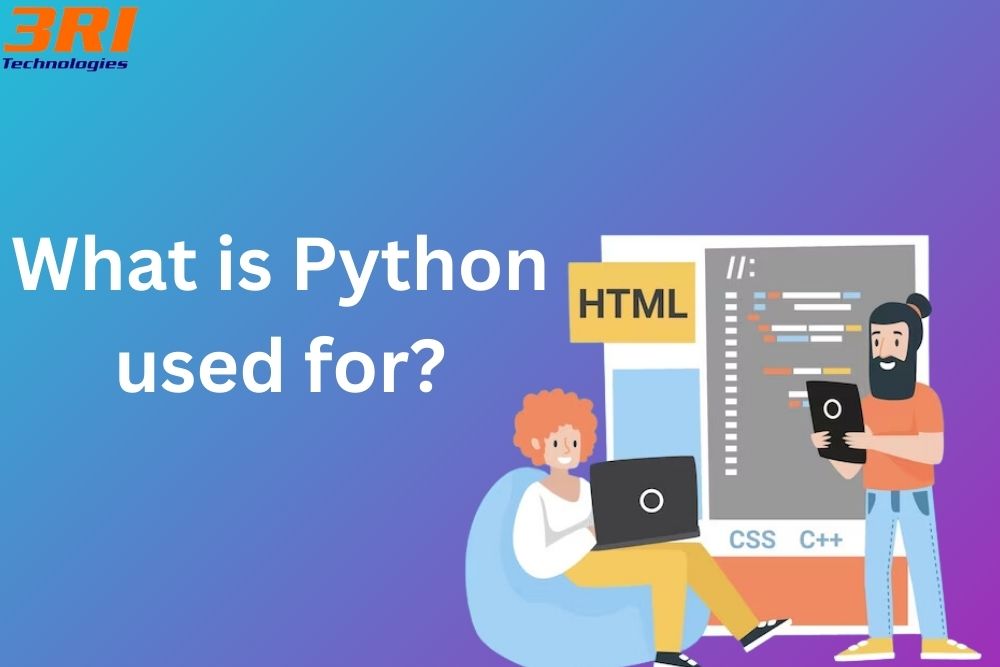What is Python?
It is possible to develop mobile apps, operating systems, artificial intelligence, machine learning, and games using the powerful, high-level programming language Python. Python’s recent popularity growth can be partly ascribed to its user-friendliness and straightforward syntax, which make it reasonably simple to get started even for newcomers and non-programmers.
Early in the 1980s, Guido Van Rossum developed Python, which has since been used in a variety of tech-related disciplines. Python 2.0, which was published in the early 2000s, gave the language a contemporary facelift while maintaining its core tenets of operation. Python is perfect for both small programs and complex Python applications because it employs object-oriented programming.
- Object-oriented:
It is object-oriented rather than function-oriented, having defined attributes and methods.
- Flexible: Because it can be used in the development of any kind of software
- Open-source: It is cost-free and available for additional development, such as the addition of practical features or bug fixes.
- High-level: Python is made to be less computer-friendly and more user-friendly Adaptable to the building of any kind of applications, having a general purpose.
Why is Python So Popular?Let’s now discuss the principal advantages of utilizing Python, which make it such a potent and well-liked programming language.
Numerous benefits of Python include the following:
Its simple to learn syntax, which is reminiscent of a natural English language, makes it extremely user-friendly for individuals who are new to programming.
Because of its human-friendly syntax, Python is easy to develop, read, and debug; it has a sizable standard library and a range of comprehensively documented additional libraries and modules; it is free for both individuals and corporations, and It has a large user base. Python’s popularity can be attributed to a number of factors, including:
- The syntax is easy to understand.
- Python’s grammar is more comparable to English’s, making it very easy to read and understand. Because of its basic layout, you can tell what each line of code accomplishes.
- Its versatility. Python has a wide range of applications, which we’ll look at in more detail later. You can use it if you are interested in web development, data visualization or artificial intelligence.
- It is easy to use.
Python is an excellent place to start for people who are unfamiliar to coding and programming. It’s a wonderful way to start growing your programming knowledge because it’s really straightforward to learn.
- The vibrant local community.
Python is a free and open-source programming language that anyone can use. A community that provides its own ideas and libraries also helps to support and enhance the ecosystem Join Our Course and Become Expert in Python Python Training in Pune
What is Python Used For?
Python’s broad range of possibilities has already been mentioned several times in this piece of writing. Let’s look at some solid circumstances where Python can be beneficial in the real world.
Python for Data Visualization
Data visualization is a standalone component of data analysis that allows us to present information, whether raw or cleaned up and transformed, in a more entertaining and instructional manner.
Python is used once more in this case, and it provides a wide range of data visualization options. The two that are based on it and are the most well-known are matplotlib and seaborn. From the most basic (line plots,histograms, and bar charts) to the most complex (streamlines, animated plots, joy plots, cluster maps, and so on), They enable us to produce a wide range of visuals.
Learn more about how to use these two Python tools by enrolling in our courses Introduction to Data Visualization with Matplotlib and Introduction to Data Visualization with Seaborn.
A bewildering variety of additional graphical libraries are also available in Python, including both general-purpose (like Plotly, Bokeh, or Altair) and more specialized ones (like missingno for visualizing missing numbers, Toyplot for creating interactive plots for electronic publication, GeoPandas for creating maps, etc.).
Python as a Software Development Language
Python is used at all phases of software development, including automated continuous compilation, build control, bug tracking, prototyping, testing, and software maintenance, as well as in data research.Due to its versatility and capability, this programming language can be used to build applications that are both somewhat simple and incredibly sophisticated multi-protocol apps or ones that include complex numeric operations.
Python enables us to develop any type of software, including GUIs, APIs, and application programming interfaces, as well as AI or ML-based audio or video apps.
Python for Task Automation/Scripting
Python is a fantastic programming language for creating scripts that automate certain monotonous jobs. Another name for this procedure is scripting.
You can use scripting, in particular, to operate with files and directories. You could, for instance, create, convert, rename, split, delete files or merge as well as change the content of the files or check them for errors, duplicates, or certain text patterns.
Python automation can also be used to discover and download data from online sources, fill out and submit web forms, and send repeating emails or notifications.
In addition to being incredibly tedious, performing all of these tasks manually would also be time-consuming and error-prone. You might dramatically improve your efficiency and free up valuable time and effort for more creative projects by using Python scripts to complete such jobs in only a few minutes. Learn more at Python Web Development Course.
What is Python used for Programming?
Before getting into why we need Python, let us first understand what Python is. Python is currently one of the most versatile programming languages in use.
Some of the salient features of Python are:
- Simplicity and flexibility
- Platform independence
- Availability of free and open-source software, FLOSS (Free/Libre and Open Source Software)
- It is a high-level language
- Supports both procedural and object-oriented programming paradigms
- It is extensible that is, it can invoke C and C++ libraries and can integrate with Java.
- It can use to make GUI applications in addition to writing vast and complex programs
- Multiple implementations are available like the CPython that is the general implementation of Python and Jython, which is the integration of Python with Java. Learn at 3RI Technologies.
The simplicity of Python with illustrations:
Consider a program where you want the user to enter something from the keyboard, and you want to save that value in a variable
C++:
#include
using namespace std;
int main(){
int x;
cin >> x;
return 0;
}

Get FREE career counselling from Experts !
Core Java:
import java.util.Scanner;
class Test{
Scanner input = new Scanner(System.in);
public static void main(String args[]){
int x;
x = input.nextInt();
}
}
Now, enter the hero, Python:
x = input()
That is all it takes. No importing of libraries, no curly braces, no semi-colons. Also, programmers don’t need to explicitly specify the data types while declaring a variable. Python compiler does the work itself, based on the type of value assigned to the variable.
Interpreter language or a compiler language?
There are two ways to convert a high-level language to a machine language, namely:
- Compilers: Compilers convert high-level programming language to machine bytecodes, and then the compiler goes through the syntax and converts the program to a CPU-understandable bytecode.
- Interpreters: Interpreters take each expression or line of the program and convert it to machine code. The program was then executed. Any syntax error in a line shall display an error only when that line is encountered, like in the Unix shell.
Python is a “COMPILED INTERPRETED” language. This can be explained further as follows:
- First, Python checks for the syntax of the program.
- Then Python compiles it and, after compilation, converts it to bytecode. The bytecode is then loaded into the system memory.
- The compiled bytecode is then interpreted from memory for execution.
Other programming languages like C convert programs to machine code and save them for execution in the disk which the user can then run as a.out
When any Python module is imported into any other program, the program directory would be .pyc, which will already be compiled.
Why Learn to Use Python?-
So now that we are aware of the current popularity of Python, why should you learn how to utilize it? Aside from the previously noted ease of use and versatility, there are several other compelling reasons for exploring Python: Python developers are in high demand.
Python programmers are in high demand across a wide range of businesses. It could be a useful skill to have if you’re looking to start or move jobs. It could lead to a rich profession. According to data, the average yearly income for Python specialists in the UK is thought to be around £65,000.
There will be many of employment options. Python is undoubtedly a skill that will never go out of vogue because it can be used in so many progressive technologies such as artificial intelligence, data analytics and machine learning. You might find employment benefits in learning Python now.
Python is an excellent choice for learning because of its many advantages, especially when used as your first programming language. Why, though, did you individually choose to learn it? The following reasons may persuade you even further:
It can provide you with numerous opportunities to start a new profession in a variety of fields, and we’ll get into more detail about which ones soon. It could end up being a beneficial addition to your existing toolbox. Python, for example, can be used to streamline a wide range of time-consuming tasks, including bulk file renaming, transforming files to another format, and the preparation and revision of job reports.
- Even when applying for jobs that don’t directly need knowing Python, it can help you stand out from the competition (for instance, you can look at a sample template for a job description for a business analyst).
- Python-related occupations are currently in high demand and compensation, and this trend will only persist in the future. You can find proof by researching the typical salary for any of the positions listed in the job related page.
- Not to mention, Python enables you to construct bots and perform other valuable tasks for yourself, like scraping webpages .Want to Upskill to get ahead in your career? Check out the Full Stack Online Course
Why use Python?
Python, being the most widely used programming language, has multiple uses:
- Web applications: Python can be utilized and implemented to make up various scalable and secure web applications. By using frameworks like Flask, Django, Pyramid, etc. several amazing web applications can be designed and developed.
- AI and ML: Artificial intelligence (AI) is a promising new development in the tech domain. Machines can be used to mimic the human brain’s ability to perform cognitive functions like learning and problem-solving. Libraries like Keras, TensorFlow can be used for building the diverse functionalities of machine learning. It helps in learning without being explicitly programmed.
- Computer software or desktop applications: GUI can be developed with the help of Python, too, with an open-source widget toolkit like Tk used for desktop application development just like Kivy.
- Scientific computing application: SciPy and NumPy are the best applications for scientific computations. They have incredible computational power with easy syntax, which makes Python very useful for scientific computing applications.
- Image processing: Image processing is basically traversing and analyzing images pixel by pixel, and Python has numerous libraries for image processing, for example, Pillow, scikit-image, etc.
- Scripting and automation: Codes are written in the form of scripts and then executed. The machine interprets the code after reading it, and error checking is made during the Runtime. After verification, the code can be used several times. Thus the tasks of the program are automated.
- Big data: Python supports parallel computing, where it can be used for Hadoop as well. Python library ‘Pydoop’ helps you write a MapReduce program in Python and process the data present in the HDFS cluster. Other libraries for big data processing include ‘Dask’ and ‘Pyspark.’
- Testing framework: Python is well suited for validating ideas for products for established companies. With many built-in testing frameworks, Python is also used for debugging and delivering the fastest workflows, with tools and modules in Selenium and Splinter that make it easier. Cross-platform and cross-browser testing such as Pytest and Robot framework is also supported. Python, in fact, makes the tedious process of testing much faster.

Do you want to book a FREE Demo Session?
Looking forward to becoming a Python Developer? Then get certified with Python Online Training
However, even with these uses, Python has some shortcomings as well. In fact, many studies have shown that other programming languages like Java are comparatively faster than Python. But, Python can be useful in case you want to develop software quickly or make software maintenance simpler.
The Uses of Python Programming Language in Scientific Computing and Data Science-
A world-class Python data processing and analytics library was developed in 2012 thanks to funding from the Defense Advanced Research Projects Agency (DARPA), which is in charge of supporting technological innovation for military purposes.
Because of this significant investment, the Python programming language today offers a wide range of advanced applications and modern packages for all areas of scientific computing and data science.
Python is best suited for scientific computing and data science, according to seasoned developers and engineers, since it provides APIs, a simple syntax, and outstanding capability to address statistics, scientific, and mathematical operations.
The data processing and analysis package in Python.
Python is the ideal programming language for scientific computing and data science, according to skilled programmers and engineers, since it provides APIs, a simple syntax, and remarkable skills to address statistics, scientific, and mathematical operations.
-
Python projects for beginners
A career in Python may be the best route to achieving your professional objectives due to the great demand for the language. With the help of online certifications from 3RI Technologies, one of the top global suppliers of online certification training, you can keep up with advancements in Python and the data sciences.
You can begin the Python Certification Course right immediately. It can assist you in learning all the Python language’s essentials and receiving practical instruction. On the other hand, the Data Scientist Master’s degree offered by 3RI Technologies could be a good fit if you want to use your understanding of Python to start a career in data science. This comprehensive bootcamp offers a learning path that is role-aligned and designed to assist you in rapidly acquiring the in-demand skills required to become a data scientist.
Therefore, we have given you a number of examples if you were unsure about how to use Python or who utilizes it. But what if you’re new to Python and want to work as a developer?
Below are a few Python project suggestions that are suitable for beginners. You can use these to test your programming language proficiency and broaden your understanding of programming languages:
- Construct a guessing game.
- Create an adventure text game.
- Make a straightforward Python calculator.
- Create a basic, interactive test.
- Construct an alarm clock
- Each of them can test you and aid in honing your Python skills once you’ve mastered the fundamentals.
-
Final thoughts
In conclusion, we covered a wide range of topics pertaining to the use of Python for various purposes, including data visualization ,machine learning and data analysis.
We also learnt what Python is and what its key benefits are, which have helped make it the most popular programming language worldwide.
Explore the extensive beginner-friendly online programs if you’re interested in continuing the exciting path of learning Python to expand your job options.
-
Python Training Offered In Different Locations are

